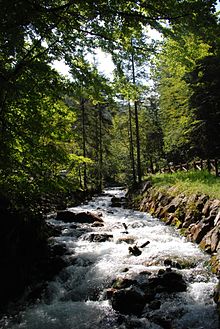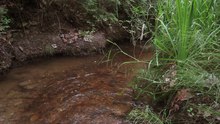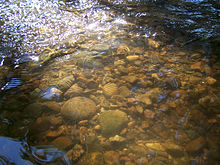Stream

Rocky stream in Italy
A stream is a body of water[1] with surface water flowing within the bed and banks of a channel. The stream encompasses surface and groundwater fluxes that respond to geological, geomorphological, hydrological and biotic controls[2].
Depending on its location or certain characteristics, a stream may be referred to by a variety of local or regional names. Long large streams are usually called rivers.
Streams are important as conduits in the water cycle, instruments in groundwater recharge, and corridors for fish and wildlife migration. The biological habitat in the immediate vicinity of a stream is called a riparian zone. Given the status of the ongoing Holocene extinction, streams play an important corridor role in connecting fragmented habitats and thus in conserving biodiversity. The study of streams and waterways in general is known as surface hydrology and is a core element of environmental geography.[3]
Contents
1 Types
2 Other names
2.1 United Kingdom
2.2 North America
3 Other terminology
4 Sources
5 Characteristics
6 Intermittent and ephemeral streams
6.1 Ephemeral stream
6.2 Intermittent stream
7 Drainage basins
8 Crossings
9 See also
10 References
11 External links
Types

A rocky creek in Spearfish Canyon, South Dakota, US
 Play media
Play mediaCreek babbling through Benvoulin, Canada wetlands

Wyming Brook in Sheffield, UK

Brook near the Bay of Fundy, Canada

A small stream in Lake Parramatta, Sydney

A low level stream in Macon County, Illinois, US
- Brook
- A stream smaller than a creek, especially one that is fed by a spring or seep. It is usually small and easily forded. A brook is characterised by its shallowness.
- Creek
- In North America, Australia and New Zealand, a small to medium-sized natural stream. Sometimes navigable by motor craft and may be intermittent.
- In parts of Maryland, New England,[4] the UK and India, a tidal inlet, typically in a salt marsh or mangrove swamp, or between enclosed and drained former salt marshes or swamps (e.g. Port Creek separating Portsea Island from the mainland). In these cases, the stream is the tidal stream, the course of the seawater through the creek channel at low and high tide.
- River
- A large natural stream, which may be a waterway.[5]
- Runnel
- the linear channel between the parallel ridges or bars on a shoreline beach or river floodplain, or between a bar and the shore. Also called a swale.
- Tributary
- A contributory stream, or a stream which does not reach a static body of water such as a lake or ocean,[6] but joins another river (a parent river). Sometimes also called a branch or fork.[7]
Other names
There are a number of regional names for a stream.
United Kingdom
Allt is used in Highland Scotland.[citation needed]
Beck is used in Lincolnshire to Cumbria in areas which were once occupied by the Danes and Norwegians.[8]
Bourne or winterbourne is used in the chalk downland of southern England.[9]
Brook.[10]
Burn is used in Scotland and North East England.[11]
Gill or ghyll is seen in the north of England and Kent and Surrey influenced by Old Norse. The variant "ghyll" is used in the Lake District and appears to have been an invention of William Wordsworth.[12]
Nant is used in Wales.[13]
Rivulet is a term encountered in Victorian era publications.[14]- Stream
Syke is used in lowland Scotland and Cumbria for a seasonal stream.[15]
North America
Branch is used to name streams in Maryland and Virginia.[16]
Creek is common throughout the United States, as well as Australia.
Falls is also used to name streams in Maryland, for streams/rivers which have waterfalls on them, even if such falls have a small vertical drop. Little Gunpowder Falls and The Jones Falls are actually rivers named in this manner, unique to Maryland.[citation needed]
Kill in New York, Pennsylvania, Delaware, and New Jersey comes from a Dutch language word meaning "riverbed" or "water channel", and can also be used for the UK meaning of 'creek'.
Run in Ohio, Maryland, Michigan, New Jersey, Pennsylvania, Virginia, or West Virginia can be the name of a stream.[citation needed]
Run in Florida is the name given to streams coming out of small natural springs.[citation needed]River is used for larger springs like the Silver River and Rainbow River.
Stream and brook are used in Midwestern states, Mid-Atlantic states, and New England.[citation needed]
Other terminology
- Bar
- A shoal that develops in a stream as sediment is deposited as the current slows or is impeded by wave action at the confluence.
- Bifurcation
- A fork into two or more streams.
- Channel
- A depression created by constant erosion that carries the stream's flow.
- Confluence
- The point at which the two streams merge. If the two tributaries are of approximately equal size, the confluence may be called a fork.
- Floodplain
- Lands adjacent to the stream that are subject to flooding when a stream overflows its banks.
- Gauging station
- A point of demarcation along the route of a stream or river, used for reference marking or water monitoring.
- Headwaters
- The part of a stream or river proximate to its source. The word is most commonly used in the plural where there is no single point source.
- Knickpoint
- The point on a stream's profile where a sudden change in stream gradient occurs.
- Mouth
- The point at which the stream discharges, possibly via an estuary or delta, into a static body of water such as a lake or ocean.
- Pool
- A segment where the water is deeper and slower moving.
- Rapids
- A turbulent, fast-flowing stretch of a stream or river.
- Riffle
- A segment where the flow is shallower and more turbulent.
- River
- A large natural stream, which may be a waterway.
- Run
- A somewhat smoothly flowing segment of the stream.
- Source
- The spring from which the stream originates, or other point of origin of a stream.
- Spring
- The point at which a stream emerges from an underground course through unconsolidated sediments or through caves. A stream can, especially with caves, flow aboveground for part of its course, and underground for part of its course.
- Stream bed
- The bottom of a stream.
- Stream corridor
- Stream, its floodplains, and the transitional upland fringe[17]
- Thalweg
- The river's longitudinal section, or the line joining the deepest point in the channel at each stage from source to mouth.
Waterfall or cascade- The fall of water where the stream goes over a sudden drop called a knickpoint; some knickpoints are formed by erosion when water flows over an especially resistant stratum, followed by one less so. The stream expends kinetic energy in "trying" to eliminate the knickpoint.
- Wetted perimeter
- The line on which the stream's surface meets the channel walls.
Sources

Small tributary stream, Diamond Ridge, Alaska, US

Creek in Perisher Ski Resort, Australia
Streams typically derive most of their water from precipitation in the form of rain and snow. Most of this water re-enters the atmosphere by evaporation from soil and water bodies, or by the evapotranspiration of plants. Some of the water proceeds to sink into the earth by infiltration and becomes groundwater, much of which eventually enters streams. Some precipitated water is temporarily locked up in snow fields and glaciers, to be released later by evaporation or melting. The rest of the water flows off the land as runoff, the proportion of which varies according to many factors, such as wind, humidity, vegetation, rock types, and relief. This runoff starts as a thin film called sheet wash, combined with a network of tiny rills, together constituting sheet runoff; when this water is concentrated in a channel, a stream has its birth. Some creeks may start from ponds or lakes.

Stream in Southbury, Connecticut, US
Characteristics
- Ranking
To qualify as a stream, a body of water must be either recurring or perennial. Recurring (intermittent) streams have water in the channel for at least part of the year. A stream of the first order is a stream which does not have any other recurring or perennial stream feeding into it. When two first-order streams come together, they form a second-order stream. When two second-order streams come together, they form a third-order stream. Streams of lower order joining a higher order stream do not change the order of the higher stream. Thus, if a first-order stream joins a second-order stream, it remains a second-order stream. It is not until a second-order stream combines with another second-order stream that it becomes a third-order stream.
- Gradient
The gradient of a stream is a critical factor in determining its character and is entirely determined by its base level of erosion. The base level of erosion is the point at which the stream either enters the ocean, a lake or pond, or enters a stretch in which it has a much lower gradient, and may be specifically applied to any particular stretch of a stream.
In geological terms, the stream will erode down through its bed to achieve the base level of erosion throughout its course. If this base level is low, then the stream will rapidly cut through underlying strata and have a steep gradient, and if the base level is relatively high, then the stream will form a flood plain and meander.
- Meander
Meanders are looping changes of direction of a stream caused by the erosion and deposition of bank materials. These are typically serpentine in form. Typically, over time the meanders gradually migrate downstream.
If some resistant material slows or stops the downstream movement of a meander, a stream may erode through the neck between two legs of a meander to become temporarily straighter, leaving behind an arc-shaped body of water termed an oxbow lake or bayou. A flood may also cause a meander to be cut through in this way.
- Profile
Typically, streams are said to have a particular profile, beginning with steep gradients, no flood plain, and little shifting of channels, eventually evolving into streams with low gradients, wide flood plains, and extensive meanders. The initial stage is sometimes termed a "young" or "immature" stream, and the later state a "mature" or "old" stream. However, a stream may meander for some distance before falling into a "young" stream condition.
- Stream load
Streams can carry sediment, or alluvium. The amount of load it can carry (capacity) as well as the largest object it can carry (competence) are both dependent on the velocity of the stream.
Intermittent and ephemeral streams

Australian creek, low in the dry season, carrying little water. The energetic flow of the stream had, in flood, moved finer sediment further downstream. There is a pool to lower right and a riffle to upper left of the photograph.
A perennial stream is one which flows continuously all year.[18]:57
Some perennial streams may only have continuous flow in segments of its stream bed year round during years of normal rainfall.[19][20]
Blue-line streams are perennial streams and are marked on topographic maps with a solid blue line.
Ephemeral stream
Generally, streams that flow only during and immediately after precipitation are termed ephemeral. There is no clear demarcation between surface runoff and an ephemeral stream,[18]:58 and some ephemeral streams can be classed as intermittent—flow all but disappearing in the normal course of seasons but ample flow (backups) restoring stream presence—such circumstances are documented when stream beds have opened up a path into mines or other underground chambers.[21]
Intermittent stream
- or seasonal stream
In the United States, an intermittent or seasonal stream is one that only flows for part of the year and is marked on topographic maps with a line of blue dashes and dots.[18]:57–58 A wash or desert wash is normally a dry streambed in the deserts of the American Southwest which flows only after significant rainfall. Washes can fill up quickly during rains, and there may be a sudden torrent of water after a thunderstorm begins upstream, such as during monsoonal conditions. These flash floods often catch travelers by surprise. An intermittent stream can also be called an arroyo in Latin America, a winterbourne in Britain, or a wadi in the Arabic-speaking world.
In Italy, an intermittent stream is termed a torrent (Italian torrente). In full flood the stream may or may not be "torrential" in the dramatic sense of the word, but there will be one or more seasons in which the flow is reduced to a trickle or less. Typically torrents have Apennine rather than Alpine sources, and in the summer they are fed by little precipitation and no melting snow. In this case the maximum discharge will be during the spring and autumn. However, there are also glacial torrents with a different seasonal regime.
In Australia, an intermittent stream is usually called a creek and marked on topographic maps with a solid blue line.
Drainage basins
The extent of land basin drained by a stream is termed its drainage basin (also known in North America as the watershed and, in British English, as a catchment).[22] A basin may also be composed of smaller basins. For instance, the Continental Divide in North America divides the mainly easterly-draining Atlantic Ocean and Arctic Ocean basins from the largely westerly-flowing Pacific Ocean basin. The Atlantic Ocean basin, however, may be further subdivided into the Atlantic Ocean and Gulf of Mexico drainages. (This delineation is termed the Eastern Continental Divide.) Similarly, the Gulf of Mexico basin may be divided into the Mississippi River basin and several smaller basins, such as the Tombigbee River basin. Continuing in this vein, a component of the Mississippi River basin is the Ohio River basin, which in turn includes the Kentucky River basin, and so forth.
Crossings
Stream crossings are where streams are crossed by roads, pipelines, railways, or any other thing which might restrict the flow of the steam in ordinary or flood conditions. Any structure over or in a stream which results in limitations on the movement of fish or other ecological elements may be an issue.
See also
- Chalk stream
- Head cut
- Playfair's Law
- River ecosystem
- Rock-cut basin
References
^ Langbein, W.B.; Iseri, Kathleen T. (1995). "Hydrologic Definitions: Stream". Manual of Hydrology: Part 1. General Surface-Water Techniques (Water Supply Paper 1541-A). Reston, VA: USGS. Archived from the original on 2012-05-09..mw-parser-output cite.citationfont-style:inherit.mw-parser-output qquotes:"""""""'""'".mw-parser-output code.cs1-codecolor:inherit;background:inherit;border:inherit;padding:inherit.mw-parser-output .cs1-lock-free abackground:url("//upload.wikimedia.org/wikipedia/commons/thumb/6/65/Lock-green.svg/9px-Lock-green.svg.png")no-repeat;background-position:right .1em center.mw-parser-output .cs1-lock-limited a,.mw-parser-output .cs1-lock-registration abackground:url("//upload.wikimedia.org/wikipedia/commons/thumb/d/d6/Lock-gray-alt-2.svg/9px-Lock-gray-alt-2.svg.png")no-repeat;background-position:right .1em center.mw-parser-output .cs1-lock-subscription abackground:url("//upload.wikimedia.org/wikipedia/commons/thumb/a/aa/Lock-red-alt-2.svg/9px-Lock-red-alt-2.svg.png")no-repeat;background-position:right .1em center.mw-parser-output .cs1-subscription,.mw-parser-output .cs1-registrationcolor:#555.mw-parser-output .cs1-subscription span,.mw-parser-output .cs1-registration spanborder-bottom:1px dotted;cursor:help.mw-parser-output .cs1-hidden-errordisplay:none;font-size:100%.mw-parser-output .cs1-visible-errorfont-size:100%.mw-parser-output .cs1-subscription,.mw-parser-output .cs1-registration,.mw-parser-output .cs1-formatfont-size:95%.mw-parser-output .cs1-kern-left,.mw-parser-output .cs1-kern-wl-leftpadding-left:0.2em.mw-parser-output .cs1-kern-right,.mw-parser-output .cs1-kern-wl-rightpadding-right:0.2em
^ Alexander, L. C., Autrey, B., DeMeester, J., Fritz, K. M., Golden, H. E., Goodrich, D. C., ... & McManus, M. G. (2015). Connectivity of streams and wetlands to downstream waters: review and synthesis of the scientific evidence (Vol. 475). EPA/600/R-14.
^ "What is hydrology and what do hydrologists do?" Archived 2014-02-22 at the Wayback Machine. U.S. Geological Survey (USGS). Atlanta, GA. 2009-05-13.
^ Spruce Creek Association. Kittery, ME. "About the Spruce Creek Watershed." Archived 2008-07-03 at the Wayback Machine. Accessed 2010-10-02.
^ Wetzel, Robert G. (2001). Limnology: Lake and river ecosystems (3rd ed.). San Diego: Academic Press. ISBN 0127447601. OCLC 46393244.
^ Krebs, Robert E. (2003). The Basics of Earth Science. Greenwood Publishing Group. ISBN 978-0-313-31930-3.
^ Bisson, Peter and Wondzell, Steven. “Olympic Experimental State Forest Synthesis of Riparian Research and Monitoring”, United States Forest Service, p. 15 (December 1, 2009).
^ "OED Online - Beck". Oxford University Press. June 2017. Retrieved 6 July 2017.
^ "OED Online - Bourne". Oxford University Press. June 2017. Retrieved 6 July 2017.
^ "OED Online - Brook". Oxford University Press. June 2017. Retrieved 6 July 2017.
^ "OED Online - Burn". Oxford University Press. June 2017. Retrieved 6 July 2017.
^ "OED Online - Gill". Oxford University Press. June 2017. Retrieved 6 July 2017.
^ "OED Online - Nant". Oxford University Press. June 2017. Retrieved 6 July 2017.
^ "OED Online - Rivulet". Oxford University Press. June 2017. Retrieved 6 July 2017.
^ "OED Online - Sike". Oxford University Press. June 2017. Retrieved 6 July 2017.
^ "OED Online -Branch". Oxford University Press. June 2017. Retrieved 6 July 2017.
^ "Stream Corridor Structure" Archived 2015-04-02 at the Wayback Machine. Adapted from Stream Corridor Restoration: Principles, Processes, and Practices
^ abc Meinzer, Oscar E. (1923). Outline of ground-water hydrology, with definitions. Washington, DC: USGS. Archived from the original on 2017-07-09. Water Supply Paper 494.
^ Meinzer, Oscar E. (1923). Outline of ground-water hydrology, with definitions. Washington, DC: US Geological Survey (USGS). p. 57. Archived from the original on 2017-07-09. Water Supply Paper 494.
^ "OSM - COALEX State Inquiry Report 97". Archived from the original on 2012-04-15. Retrieved 2011-12-11.
^ Black Creek (Susquehanna River)#Hydrology_and_climate, `Black Creek is an ephemeral stream. It used to drain an area between Turtle Creek and the Susquehanna River, but now loses its flow to underground mines via broken bedrock. Its channel is also disrupted by strip mines and rock piles.', 14 Nov 2016.
^ Langbein, W.B.; Iseri, Kathleen T. (1995). "Hydrologic Definitions: Watershed". Manual of Hydrology: Part 1. General Surface-Water Techniques (Water Supply Paper 1541-A). Reston, VA: USGS. Archived from the original on 2012-05-09.
External links
| Look up stream in Wiktionary, the free dictionary. |
| Wikimedia Commons has media related to Streams. |
| Wikiquote has quotations related to: Streams |
Glossary of stream-related terms, StreamNet
